24 Hours Hotline: +8613735411378
Email:chengdu@tripstoshanghai.com
24 Hours Hotline: +8613735411378
Email:chengdu@tripstoshanghai.com
Decoding Hotpot Culture: From Humble Origins to Cultural Icon
Chongqing hotpot is more than a meal—it’s a story of resilience, community, and fiery passion. Here’s how a simple cooking method evolved into a cultural phenomenon.
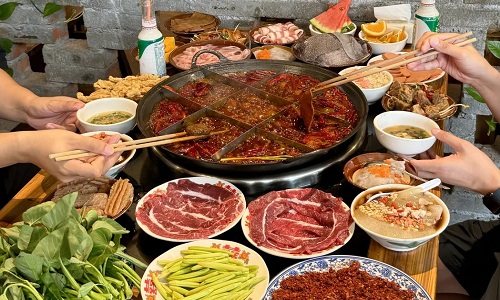

Historical Roots
1. Yangtze River Boatmen’s Invention
In the late 19th century, Chongqing’s bangbang jun (porters) working along the Yangtze created the earliest hotpot:
Used cheap offal (tripe, liver, intestines) discarded by wealthy households.
Boiled spices in iron pots to mask strong odors and add calories.
Shared pots to save fuel and build camaraderie.
Fun Fact: The original broth was water + chili + Sichuan peppercorns—no oil!
2. WWII Partition Cooking
During Chongqing’s time as China’s wartime capital (1937-1946), hotpot became a survival tool:
"Nine Grids" were invented to let multiple groups share one pot during shortages.
Each grid cooked different ingredients: tough meats in simmering corners, quick-cook veggies in boiling center.
Coal-fired stoves replaced open fires for longer cooking.
Heritage Spot: Hongyadong’s old hotpot lanes still preserve this style.
3. 1980s Air-Raid Shelter Era
Post-war, entrepreneurs turned bomb shelters into hotpot restaurants:
Natural insulation kept broths simmering perfectly.
Low rents made meals affordable for working-class families.
Eerie-cool atmosphere became a tourist draw.
Still Operating: Cave Hotpot near Liziba Station.
Cultural Symbols
1. "Harmony in Diversity" Dining Philosophy
Hotpot embodies Chinese collectivism with individual freedom:
Shared pot - Collective unity
Personal dipping sauces - Individual expression
Ingredients chosen by each diner - Balance between group and self
Social Rule: Never take the last piece without offering it to others first.
2. Boiling Red Broth - Chongqing Spirit
The raging crimson pot mirrors the city’s personality:
Spiciness - Resilience against summer heat and wartime bombs
Constant boiling - Nonstop energy of mountain-life hustle
Oil layer insulating heat - Outward toughness hiding inner warmth
Metaphor: Locals say life is like hotpot—"you gotta endure the heat to get the flavor."
3. Dipping Sauce as Identity
Your youdie (oil dip) reveals your background:
Purists: Only sesame oil + garlic (respects the broth)
Innovators: Soy sauce + cilantro + peanut crumbs (fusion style)
Rebels: Dry chili powder + salt (intensity seekers)
Pro Tip: Old-schoolers never mix sauces—it’s considered disrespectful to the chef’s broth craft.
Why This Matters
Understanding hotpot’s past isn’t just food trivia—it’s key to ordering like a local, avoiding cultural faux pas, and appreciating how struggle shaped Chongqing’s soul.
The Secrets of Broth: Decoding Chongqing Hot Pot’s Soul
At the heart of every Chongqing hot pot lies the broth—a complex, simmering masterpiece that defines the entire dining experience. Here’s how to navigate the world of Chongqing broths, from traditional recipes to modern innovations.
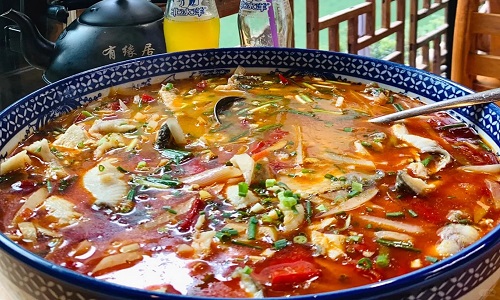
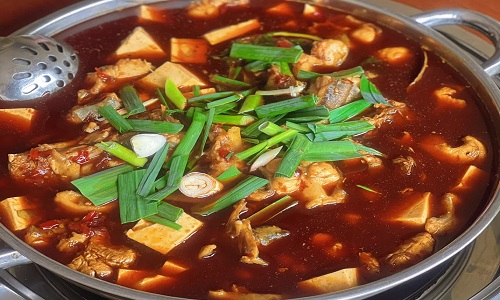
Types of Broth
1. Old-School Hot Pot
This is the original Chongqing style, known for its bold, pungent flavors and rich history.
Key Ingredients:
Beef Tallow: Provides a dense, aromatic base that clings to ingredients.
Lao Yin Tea: A dark, fermented tea that reduces greasiness and adds depth.
Shizhu Red Chili: A famously potent chili variety from Shizhu County.
Flavor Profile:
Strong, smoky, and numbing (mala).
The broth thickens as it simmers, intensifying the flavor.
Best For: Adventurous eaters who crave authenticity.
2. New-School Hot Pot
A modern take that focuses on balance and complexity without overwhelming spice.
Key Ingredients:
Rapeseed Oil: Lighter than beef tallow, allowing other flavors to shine.
Spice Blends: Star anise, cinnamon, sand ginger, and dozens of other spices.
Flavor Profile:
Layered and aromatic, with a clearer broth.
Less greasy, making it easier to enjoy for longer meals.
Best For: Those who prefer nuanced flavors over intense heat.
3. Regional Variations
Chongqing’s diverse regions have their own unique twists on hot pot.
Qianjiang Chicken Gizzard:
A sour-spicy broth with pickled chilies and chicken gizzards.
Served in a smaller pot for quicker cooking.
Beidu Fish Hot Pot:
A light, tomato-based broth with fresh river fish.
Garnished with cilantro and fried soybeans.
Spice Level Codes
1.Chili Ratios
Chongqing hot pots are categorized by spice levels, each with a precise blend of chilies and Sichuan peppercorns.
Level Chili Ratio Sichuan Peppercorn Ratio Sensation
Mild 30% 10% Warm, slight tingle
Medium 50% 20% Noticeable heat + numbness
Extra Spicy 70% 25% Fiery, mouth-numbing
2."Hell Spice" Challenge
Some restaurants offer an Anal Pain level—a brutal test of endurance.
Ingredients:
Ghost Peppers plus Sichuan Peppercorns: For intense heat and numbness.
Extra Beef Tallow: To amplify the spice.
How to Survive:
Dunk ingredients in oil to reduce surface spice.
Avoid breathing in the steam—it can make you cough!
3.Reducing Spice Without Losing Flavor
If the broth becomes too spicy, try these tricks:
Add Fermented Rice:
Sweetness balances heat while adding complexity.
Drop in Rock Sugar:
Dissolves slowly, subtly counteracting spice.
Skim Off Chili Oil:
Remove excess oil from the surface to reduce heat.
Pro Tips
Order a Yuan Yang Pot: Split broth (half spicy, half mild) for flexibility.
Simmer Spices Longer: For milder spice, let the broth cook longer—this mellows the chilies.
Ask for "La Duo Ma Shao": "More chili, less numbing" if you prefer heat over tingle.
Final Thought
The broth is the soul of Chongqing hot pot—whether you’re diving into the bold, traditional old-school style or exploring modern and regional variations. Understanding these secrets will help you customize your experience and enjoy every bite like a true local.
The Hotpot Ingredient Encyclopedia: From Classic Must-Haves to Secret Menu Items
Chongqing hotpot isn’t just about the broth—it’s a carnivore’s paradise with an artistry to selecting and preparing each ingredient. Here’s your guide to navigating the menu like a local.
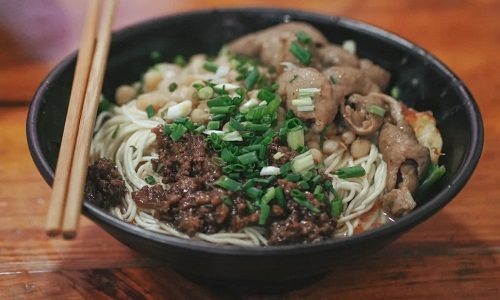

Classic Must-Haves
1. Slaughterhouse-Fresh Tripe
What It Is: The second stomach of cattle, prized for its crunchy texture.
15-Second Rule: Dip in boiling broth for exactly 15 seconds until it curls slightly. Overcooking turns it rubbery.
Quality Test: Fresh tripe should smell clean (not sour) and have springy texture. Avoid slimy or discolored pieces.
Local Secret: The best tripe comes from water buffaloes (thicker and crisper).
2. Broad-Sliced Pork Kidney
De-funking Technique:
Soak in cold water with Sichuan peppercorns for 30 mins
Scrape off white membranes (source of odor)
Rinse with beer or rice wine before slicing
Cutting Style: Shaved paper-thin to cook in 5 seconds
Serving Trick: Arranged on ice to maintain crispness
3. Duck Intestines
Freshness Check:
Color: Pinkish-white (not gray or green)
Texture: Firm and elastic (not mushy)
Smell: Ocean-like (not ammoniac)
Cooking Method: Swish in broth for 8-10 seconds until curled
Pro Tip: Order "nest-style" intestines—they’re pre-bundled for easy cooking.
Hidden Menu Items
1. Pork Brains
Membrane Removal:
Soak in salt water for 20 mins
Gently peel off blood vessels with fingers
Rinse under cold water
Cooking Time: 15 mins in simmering broth (until creamy)
Best Dip: Chili powder + peanut crumbs (balances richness)
2. Pork Palate
What It Is: The roof of a pig’s mouth—crunchy and cartilage-like.
Preparation: Boiled for 2 hours then flash-frozen for texture
Cooking: Just 30 seconds in hot broth (overcooking makes it tough)
Local Name: Called "pig heaven" for its addictive texture
3. Live-Sliced Eel
Freshness Standard: Killed within 2 hours of serving
Butchering Trick:
Blanched in hot water to remove slime
Bones removed while still twitching
Cooking: 3-4 minutes until flesh firms up
Safety Note: Always choose restaurants with aquariums on-site
Ingredient Cooking Guide
Ingredient Cooking Time Doneness Sign
Tripe 15 seconds Edges curl slightly
Kidney 5 seconds Turns opaque
Duck Intestines 8-10 seconds Tightly curled
Pork Brains 15 minutes Creamy texture
Pork Palate 30 seconds Curls into rings
Fresh Eel 3-4 minutes Flesh firms up
Pro Tips from Hotpot Masters
Ordering Code: Ask for slaughterhouse fresh for the best quality.
Dip Pairings:
Tripe - Sesame oil + garlic
Brains - Dry chili dip
Eel - Chopped cilantro + soy sauce
Avoid: Frozen tripe —it’s often chemically treated.
Final Thought
In Chongqing hotpot, every ingredient tells a story—from the 15-second precision of tripe to the twitching freshness of eel. Be bold, try the "weird" parts, and remember: the best meals often come from trusting the chef’s hidden menu.
The Art of Dipping Sauce: Crafting Your Chongqing Hotpot Experience
In Chongqing hotpot, the dipping sauce isn’t just a condiment—it’s a personalized flavor canvas that balances spice, enhances umami, and cools the palate. Here’s how to master the art.
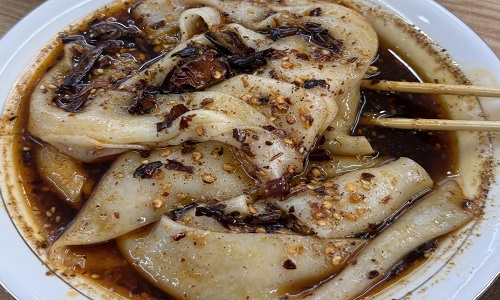
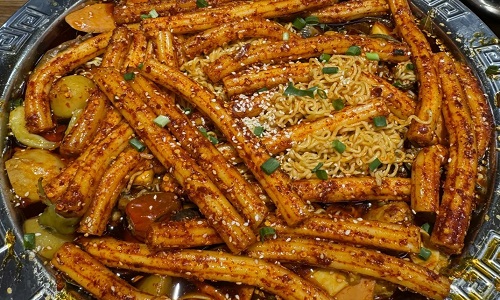
Classic Dipping Styles
1. Classic Garlic Oil Dip
The default choice for locals:
Base: Sesame oil + minced garlic (ratio: 3:1)
Function: Cools scorching ingredients & enhances fragrance
Pro Tip: Add a few drops of Yacai (pickled mustard greens) for crunch
2. Dry Spice Mix
For heat seekers who want extra kick:
Recipe:
2 tbsp chili powder (preferably Chao Tian Jiao)
1 tbsp crushed peanuts
1 tsp sesame seeds
Pinch of Sichuan pepper
Best With: Fatty meats like ribs or crispy pork
3. Complex Sauce Blend
A rich, multi-layered option:
Base: Fermented soybean paste + seafood sauce
Add-ins: Chopped leeks + cilantro + crushed fermented tofu
Perfect For: Dipping mushrooms and tofu skins
Creative Customizations
1. Spice Neutralizer
Can’t handle the heat? Try:
Formula: Black vinegar (50%) + sugar (30%) + minced chili (20%)
Science: Acidity and sugar counteract capsaicin’s burn
Pro Move: Add crushed ice for instant cooling
2. Umami Booster
Elevate natural flavors:
Mix: Oyster sauce + finely chopped celery + fried soybeans
Secret: A few drops of truffle oil (for luxury versions)
Ideal With: Seafood and leafy vegetables
3. Low-Calorie Version
For health-conscious diners:
Base: Fresh lemon juice + steamed fish soy sauce
Add: Minced ginger + scallions
Calorie Save: 60% less fat than oil dips
Dipping Sauce Comparison Guide
Sauce Type Best For Spice Level
Garlic Oil Beginner Mild Medium
Dry Spice Meat lovers Extreme Low
Umami Booster Seafood/veggies Mild Low
Neutralizer Sensitivity None Low
Pro Tips from Locals
Layer Flavors: Start with base oil, then add powders, finally fresh herbs.
Customize by Ingredient:
Use dry dip for fatty meats
Choose umami sauce for mushrooms
Replenish Wisely: Don’t overcrowd your bowl—refresh sauces every 40 minutes.
Why It Matters
Your dipping sauce is your personal shield against fire and your flavor amplifier. As the old Chongqing saying goes: "No sauce, no soul."
The Ultimate Chongqing Hotpot Cooking Guide: Timing & Rescue Techniques
Getting the perfect texture in Chongqing hotpot is a science of seconds. Under-cook, and you risk parasites; over-cook, and treasures turn rubbery. Here’s your foolproof manual to mastering the boil.

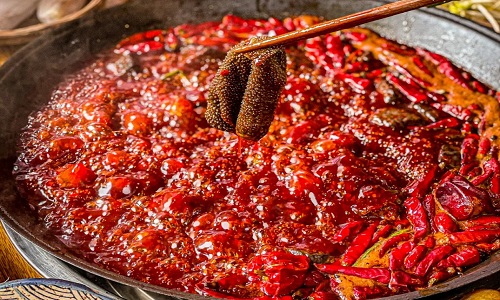
Second-by-Second Cooking Times
1. Crispy & Tender Items
These require precision timing—a few seconds too long ruins them.
Ingredient Ideal Time Doneness Signal
Beef Tripe 8-12 seconds Curls slightly with bubbly surface
Pork Aorta 20 seconds Turns creamy white, curls at edges
Duck Intestine 10-15 seconds Shrinks into a tight ring
Pro Tip: Use chopsticks as a timer. Hold tripe with them—release after counting "8-9-10"!
2. Slow-Cook Items
These need patience and low heat to absorb flavors.
Ingredient Ideal Time Doneness Signal
Pork Brain 15 minutes Turns opaque like soft tofu
Braised Beef 30 minutes Pulls apart with gentle pressure
Taro 20 minutes Easily pierced with a chopstick
Pro Tip: Cook these first—drop them in before the broth fully boils.
3. Instant-Cook Items
For the brave: fresh ingredients that cook in flash time.
Ingredient Ideal Time Risk Level
Pork Kidney Slices 5 seconds High (overcooks instantly)
Live Loach 15-20 seconds Extreme (may jump!)
Fresh Eel 12 seconds Medium (bones if undercooked)
Warning: Always use a lid for live seafood to prevent "hotpot eruptions"!
Food Rescue Techniques
1. Reviving Overcooked Meat
If your beef turns rubbery:
Soak in hot broth + 1 tsp of oil for 2 minutes
Add a slice of potato—its enzymes tenderize proteins
For extreme cases: Chop and repurpose into fried rice
2. Fixing "Woody" Textures
When chicken/pork becomes dry:
Dunk in sesame oil + garlic mix for 60 seconds
Wrap in lettuce with a dash of soy sauce
Shred and toss with chili oil as a salad
Quick-Reference Table
Category Ingredients Timing Rescue Tip
Crispy Tripe, Intestine <20s Serve immediately
Slow-Cook Brain, Beef 15-30min Cook first, low heat
Instant Kidney, Loach 5-20s Use lid for safety
Tough Meat Lamb, Chicken - Oil soak + shred
Pro Tips from Old-School Chefs
"Seven Up, Eight Down" for tripe: Dip 7 times, boil 8th time.
Never overcrowd—cook in small batches for even heat.
Skim foam regularly to keep broth clear.
Remember: Chongqing hotpot is 80% ingredients, 20% timing. Practice with a stopwatch until it becomes instinct!
How to Choose a Hotpot Restaurant: Iconic Brands & New Trends
Choosing where to eat hotpot in Chongqing is like selecting a fine wine—each establishment has its own history, secret recipes, and loyal followers. Here’s your guide to navigating the city’s hotpot scene, from decades-old classics to viral newcomers.
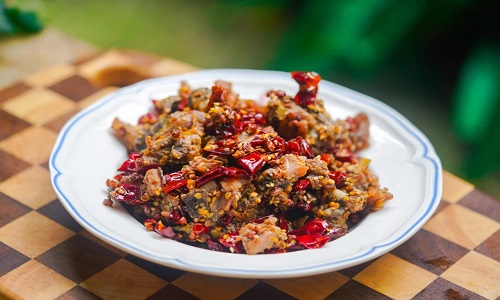
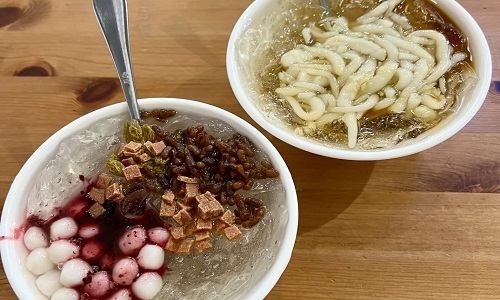
Decoding the Old-School Legends
1. Dongting Hotpot – The Cave Experience Pioneer
Nestled in a repurposed Cold War-era air-raid shelter, Dongting offers more than just food—it’s a historical immersion.
Why It’s Unique:
Underground dining chambers with natural temperature control (18°C year-round)
1960s military artifacts on display (gas masks, propaganda posters)
Echoing tunnels amplify the sound of boiling broth
Must-Order:
Cave-aged blood pudding (texture like tofu)
Special pickled garlic (only served here)
Location: 58 Shangqingsi Road, Yuzhong District (hard to find—look for the unmarked iron door)
2. Xiaoyu Hotpot – The ‘Bite of China’ Star
Featured on CCTV’s hit show, this family-run spot put traditional (chao liào) spice-frying techniques on the national map.
Signature Style:
Charcoal-fired copper pots (rare in modern shops)
Daily hand-pounded chili paste
No MSG—just pure spice layers
Pro Tip:
Ask for the "hidden menu" offal platter (includes fresh goat stomach)
Location: 1-3-1 Pipa Mountain Road, Nan'an District (original location)
3. Dalong Hotpot – The Artisan’s Choice
A cult favorite among chefs for its uncompromising traditional methods.
Craftsmanship Highlights:
Stone-ground chilies (not machine-blended)
72-hour bone broth base
Wooden ladles only (metal alters flavor)
Warning:
No mild broth option—their motto is "spicy enough to make you jump"
Location: 288 Huancheng Road, Shapingba District (look for the line of locals with takeaway jars)
New Wave Hotpot Revolution
1. Zhou Shixiong – The Knife Skills Master
Famous for inventing "transparent knife-sliced waist"—a patent-winning technique.
Innovations:
-30°C frozen slicing creates paper-thin waist slices
15-second guarantee—overcooked waist replaced free
Open kitchen with knife skills performances
Must-Try:
Rainbow platter (6 types of marinated beef)
Location: Multiple branches; flagship at Jiefangbei
2. Peijie – The Queuing Phenomenon
This brand turned waiting into marketing—their 4-hour queues are legendary.
Queue Strategy:
WeChat pre-booking (releases slots at midnight)
Live queue updates on their app
Waiting perks: free foot massages + snacks
Secret:
Go at 3 AM—their only non-peak hour
Location: 108 Minquan Road, Yuzhong District (24/7 operation)
3. Lu Xiaozhang – Hotpot x Braised Fusion
The first to combine Sichuan braised dishes with hotpot.
Game Changers:
7 free dessert bar (matcha cakes, ice cream)
Table-side braising carts
DIY spicy level (choose your own chili blend)
Don’t Miss:
Braised pig’s ear to eat pre-hotpot
Location: 99 Guihua Street, Yubei District
Comparison Table: Old vs New
Feature Old-School (e.g., Dalong) New Wave (e.g., Peijie)
Broth Heavy(beef fat) base Lighter blends + herbal options
Ambiance Barebones, communal tables Instagrammable decor
Innovation Traditional techniques Tech integration (apps, IoT pots)
Price ¥80-100/person ¥120-150/person
How to Choose Your Vibe
For Authenticity: Old-school (e.g., Dongting)
For Comfort: New wave (e.g., Zhou Shixiong)
For Adventure: Fusion (e.g., Lu Xiaozhang)
Local Insight: Many Chongqing natives actually prefer small neighborhood joints over famous names—look for places filled with older men playing mahjong while eating.
Healthy Eating Guide: Enjoy Hotpot Without the Regret
Chongqing hotpot doesn’t have to be a gut-busting experience. With these science-backed strategies, you can savor the fiery flavors without sacrificing your stomach or waistline.


Gut Protection Strategies
1. The Oil Dip Barrier Method
The traditional sesame oil + garlic dip isn’t just for flavor—it’s a protective layer for your digestive system:
Oil Coating: Forms a temporary barrier on your stomach lining, reducing direct irritation from capsaicin (the compound that makes chilies hot).
Cooling Effect: Sesame oil has a cooling property that counteracts the burning sensation.
Pro Formula: 70% sesame oil + 20% crushed garlic + 10% cilantro (add a dash of vinegar for extra protection).
2. Veggies-First Eating Order
Start with fibrous vegetables before moving to meats:
Soluble Fiber (potatoes, lotus root) absorbs excess oil and slows capsaicin absorption.
Creates a Buffer in your stomach, reducing direct chili contact.
Avoid: Cooking leafy greens (like lettuce) early—they become oil sponges.
3. The Science of Cooling Foods
Yogurt: The casein protein binds to capsaicin and washes it away (like soap cutting grease).
Bing Tang Yuan: The icy sweetness overwhelms pain receptors, providing instant relief.
Other Helpers: Whole milk (more effective than water) and starchy rice (absorbs oils).
Calorie Control Tactics
1. Low-Calorie Ingredient Picks
Ingredient Calories (per 100g) Why It’s Smart
Konjac 7 kcal 97% water + fiber, fills you up
Bamboo Shoots 27 kcal Crunchy texture, oil-resistant
White Radish 18 kcal Natural sweetness balances spice
2. Oil-Skimming Techniques
The Swirl: Use your ladle to swirl the broth—oil gathers at the center for easy skimming.
Ice Trick: Drop an ice cube in your ladle; oil sticks to it (traditional street method).
Leafy Blotter: Briefly dip fatty meats in lettuce leaves before eating to absorb excess oil.
3. Drink Smart: Beer vs. Wei Yi Soy Milk
Drink Calories (500ml) Pros/Cons
Beer 215 kcal Increases capsaicin absorption (worse burn)
Wei Yi Soy Milk 180 kcal Protein soothes stomach, less sugar than soda
Winner: Light Jasmine Tea (0 kcal, aids digestion)
Quick Science Note
Capsaicin triggers pain receptors (TRPV1), but fat/oil dissolves it better than water. That’s why oil-based dips and dairy are more effective than drinking water.
Pro Tip: The 60-Minute Rule
Eat for no longer than 60 minutes—after that, the broth becomes concentrated with sodium and oil.
Regional Rivalry: Chongqing vs. Chengdu Hotpot Showdown
To understand Chongqing hotpot is to recognize its fiery rivalry with Chengdu—a culinary battle that divides Sichuan province. While both share the málà (numbing-spicy) tradition, their philosophies diverge dramatically. Here’s how to tell them apart like a local.

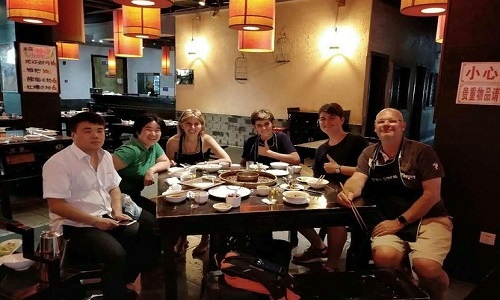
The Broth Battle: Oil Base & Flavor Profiles
Oil Base: Beef Tallow vs. Vegetable Oil
Chongqing Style:
Beef Tallow: Rich, animal-fat depth that clings to ingredients.
Intense Umami: Absorbs into meats for a heavier, grittier texture.
High Smoke Point: Handles relentless boiling without turning bitter.
Chengdu Style:
Vegetable Oil: Lighter, floral notes from rapeseed/blend oils.
Herbal Complexity: Often includes more spices (star anise, cinnamon).
Gentler on Stomach: Preferred by those who want flavor without the grease.
Pro Tip: Dip a spoon—Chongqing broth solidifies when cool (thanks to tallow); Chengdu’s remains liquid.
Dipping Sauce Culture
1. Chongqing: Simplicity is King
Classic Oil Dip: Just garlic + sesame oil—designed to cool food and enhance freshness.
Why: The broth is so powerful, it doesn’t need masking.
2. Chengdu: Creative Combinations
Dry Dip Mix: Chili powder, peanut, sesame seeds, MSG.
Sesame Paste Base: Often mixed with cilantro, garlic, and fermented tofu.
Cultural Insight: Chongqing dips are functional; Chengdu’s are flavor-augmenting.
Spice Tolerance Spectrum
Level Chongqing Interpretation Chengdu Interpretation
Mild "Not really an option" Blended chili oil
Medium Tourist spice level Standard málà
Spicy Local’s daily default "Face-numbing"
Death "Hell Level" Reserved for daredevils
Warning: Chongqing’s "medium" is often Chengdu’s "spicy".
Local Eating Rituals
1. "Cold Pot Blood"
What: Adding fresh duck blood pudding to the broth before it boils.
Why: It cooks slowly, absorbing maximum flavor without breaking apart.
Pro Move: Exclusive to Chongqing old-school spots.
2. "Noodle Finale"
What: Ending the meal by cooking hand-torn dough slices in the spent broth.
Why: Soaks up all the accumulated meat/seafood essences.
Chengdu Contrast: They prefer finishing with rice instead.
3. "Summer Heat Attack"
What: Gulping ice-cold beer with boiling hotpot in 40°C weather.
Science: Triggers sweating - cools the body (TCM philosophy).
Where: Only in Chongqing’s street-side plastic stool setups.
Geographic Humor
Locals joke:
"Chengdu hotpot is for flirting; Chongqing hotpot is for fighting."
"Chengdu cares about how it looks; Chongqing cares about how it hits."
How to Experience Both
In Chongqing: Try Laozao Hotpot for unapologetic tallow brutality.
In Chengdu: Visit Long Senyuan for refined herbal blends.
Final Word: Chongqing hotpot isn’t a meal—it’s a blood sport. Come hungry, leave transformed.
Local Life Experiences: Authentic Chongqing Stays
For travelers who want more than just a hotel, Chongqing offers unique community-based stays that immerse you in local culture. These hidden gems reveal the city’s real character—beyond the tourist hotspots.
Community-Based Stays
1. Dance with Locals: Square-Dance Friendly Guesthouses
Stay in traditional residential compounds where you can:
Join evening bàbà wu – Chongqing’s beloved square-dancing ritual
Learn moves from "dance aunties" in nearby plazas
Sip tea with seniors playing mahjong under banyan trees
Best Pick: Shancheng Alley Guesthouse (near Jiaochangkou)
Perk: Free local dance costume rental for photos
Photo Tip: Capture the golden hour glow on dancers at 7 PM
2. Urban Farming Hotels
Rooftop gardens where guests can:
Harvest chili peppers & Sichuan peppercorns
Cook with chefs using picked ingredients
Join "moonlight vegetable markets" (summer nights)
Best Pick: Nongtang Rooftop Hotel (Yuzhong District)
Unique Feature: Make your own hotpot base from garden spices
Note: Some require 2-night stays for farming activities
Behind-the-Scenes Stories
1. Bai Xiang Street’s Century-Old Rebirth
The Heritage House Hotel was:
Built in 1921 as a French concession trading post
Secretly used as a WWII resistance meeting spot
Reborn in 2019 with original wooden beams + shikumen gates
Exclusive: Nightly "hidden history" storytelling sessions by descendants of the original owners
2. Cable Car Crew’s Dorm Turned Hostel
This quirky hostel near the Yangtze River Cableway:
Keeps 1980s bunk beds (now upgraded with memory foam)
Displays vintage cable car parts as decor
Offers "driver for a day" experiences (operate a simulator)
Fun Fact: The rooftop bar’s signal flags teach Morse code used by old cable operators
Pro Tips for Booking
For Culture Lovers
Ask about "unscheduled noodle-making demos" at farm hotels
Heritage hotels often have unlisted cheaper rooms (call directly)
For Solo Travelers
Cable Car Hostel runs weekly spicy hotpot mixers
Dance guesthouses organize "Chongqing slang crash courses"
For Families
Urban farms offer kids’ planting workshops
Avoid square-dance spots if sensitive to evening noise (7-9PM)
Staff Confessions
"Room 302 at Heritage House has hidden bullet marks from 1940s"
"Farm hotel’s best chilies are stolen by guests—pick discreetly!"
"Cable Car’s ‘driver experience’ includes fake breakdown acting"
Final Thought
As hostel owner Old Zhang says: "We don’t sell beds—we sell Chongqing’s heartbeat." These stays turn your trip into living history.
Cultural Immersion: Beyond the Hot Pot
Chongqing's soul lives in its fiery food culture and creative spin-offs. For travelers craving more than a meal, here’s how to dive deep into the world of málà (numbing-spicy) magic.
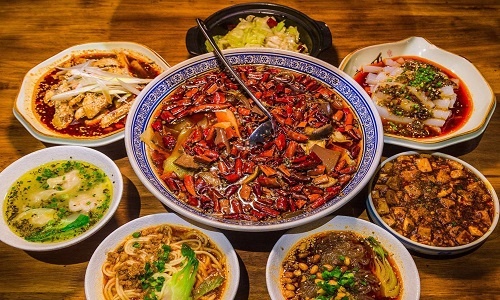
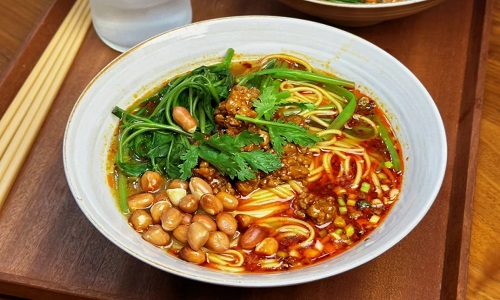
Hot Pot Academy: From Farm to Pot
1. Spice Master Workshops
Join 3-hour intensive classes led by veteran chefs:
Toast Sichuan peppercorns & chilies over iron woks
Blend 20+ spices into signature base oils
Take home your custom málà blend (vacuum-packed)
Top Pick: Hongyadong Folk Spice Studio (2pm daily, 198 RMB/person)
2. Hot Pot Museum Tour
At DeZhuang Museum, witness:
The Guinness World Record giant hot pot
Historical artifacts: Bronze hot pots from Qing Dynasty
Interactive displays: "Smell test" spice walls
Insider Tip: Ask staff to show the secret fermentation lab where "old oil" is scientifically aged
3. Market Sourcing Adventure
Navigate Xuetianwan Market with a chef:
Identify fresh beef tripe by texture & color
Taste-test 15 chili varieties (from "mild" to "face-numbing")
Haggle like a local using Chongqing slang: "Piàn yì dianr ma!"
Creative Spin-Offs: Souvenirs with a Kick
1. Hot Pot Scented Products
Málà Candles by Spice Alchemy (burns with chili-shaped wax)
Simmering Broth Diffusers – Your hotel room smells like a hot pot den
2. Edible & Usable Gifts
Chili Chocolate Bars (from local brand Fire&Bean)
Beef Tallow Soap – Cleanses pores with Sichuan peppercorn grit
3. Tech-Enhanced Experiences
VR Hot Pot Simulator at Jiefangbei Tech Hub:
"Cook" virtual ingredients with haptic chopsticks
Compete in "Daredevil Spice Challenges"
Hot Pot Proficiency Test
Take this self-assessment before ordering:
Level Tolerance Recommended Order
Newbie Can’t handle black pepper Yuanyang pot (half mild)
Apprentice Adds Tabasco to eggs Medium spice + bingfen cooler
Local Drinks broth straight "Extra numb" + spice encryption
Pro Tip: Show this table to waitstaff—they’ll respect your level!
Secret Codes & Hacks
1. Underground Ordering Phrases
"Ti¯ hú" = "Add broth" (literal: "lift pot")
"Jia má" = "More numbing!"
"Là dù jia mì" = "Encrypt spice level" (means: make it brutal)
2. Queue-Jumping Secrets
Off-peak hours: 3-5pm (chefs are fresher too!)
WeChat mini-apps: Pre-order from museums/hotels to skip lines
3. DIY Abroad Guide
Can’t find pig aorta? Substitute with:
Beef tripe - calamari rings (similar texture)
Sichuan peppercorns - black pepper + lemon zest
The Science Behind the Magic
1. Microbial Alchemy
Chongqing’s famed "lao yóu" (recycled oil) is:
Fermented with probiotics (like kimchi)
Lab-tested for safety (strains named Málàcoccus)
Aged 7 days for umami depth
2. Color-Decoding Broth
Murky brown = Well-aged, complex
Blood red = Fresh chilies, aggressive heat
Orange sheen = High beef tallow content
Hot Pot Etiquette 101
Never double-dip cooking chopsticks
Strainer spoons are for public use
Ladle broth to others to show respect
Last noodle = Long life (don’t break it!)
Final Word
Chongqing hot pot isn’t just food—it’s chemistry, social theater, and cultural identity. Master these elements, and you’ll leave with more than just spicy memories.
Explore Your Way Holiday’s Best Recommended Tours.
We design private and Tailor-made Chongqing Tours customized to your style of travel at affordable local prices. We will provide a private & spacious car and a local professional tour guide with over 5 years guiding experience only work for you or your group. Transport, ticket, and dining (We find the most authentic dishes popular with locals) all we will arrange for you according your requirements. Please check our most popular tours below:
Are the above sample tour programs not suitable for you? Dont worry, our Chongqing Tour Can Be Tailor-made based on your requirements and budget to create unique Beijing experiences that allow you to interact with the local people and culture. We are Beijing travel experts who know what your guidebook and foreign agencies don't. Our enthusiastic tour expert will promptly reply you in details within 24 hours.
Prev: Best Restaurants in Chongqing, China Where to Eat in the Mountain City
Next: Top Luxury Hotels in Chongqing Where to Stay for an Unforgettable Experience
Wechat: Chinaprivatetour
24 Hours Hotline:
+8613735411378
1 to 1 tailor-made service from our professional travel advisors for the most sophisticated
Constantly excellent reviews for attraction, hotel and service Competitive price
Local experts provide quality tours Best selected knowledgeable local guides Authentic local restaurants
7*24 hours available to create you a worry-free tour. No Hidden Fees and absolutely no pressure to buy. Secured







